“Global Configuration Management Market to reach a market value of USD 6.9 Billion by 2031 growing at a CAGR of 15.0%”
The Global Configuration Management Market size is expected to reach $6.9 billion by 2031, rising at a market growth of 15.0% CAGR during the forecast period.
The rapid pace of digital transformation, particularly in countries like China, India, Japan, and South Korea, is fueling demand for these management solutions in this region. With the rise of cloud computing, e-commerce, and smart manufacturing, organizations in Asia Pacific increasingly recognize the importance of maintaining well-configured IT environments to ensure efficiency and scalability. Consequently, the Asia Pacific region would acquire 29% of the total market share by 2031.
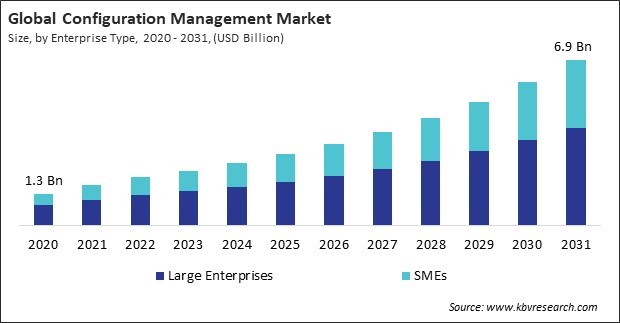
The major strategies followed by the market participants are Partnerships as the key developmental strategy to keep pace with the changing demands of end users. For instance, in July, 2024, ServiceNow, Inc. partnered with StarHub, a telecommunications company, to integrate StarHub's Enterprise Solutions with ServiceNow's Now Platform, enhancing service management through Automation and AI. This partnership streamlines operations with multi-cloud architecture, Cloud Infinity, and features like Service Bridge and AIOps, improving efficiency, compliance, and customer experience. Moreover, in June, 2024, Amazon Web Services, Inc. announced a partnership with Qlik, a software company, enhance enterprise AI with Qlik’s analytics and AWS’s cloud technologies. The partnership focuses on accelerating AI app development, streamlining data compliance, and boosting AI adoption through co-marketing and co-selling initiatives.
Based on the Analysis presented in the KBV Cardinal matrix; Microsoft Corporation are the forerunners in the Market. In September, 2023, Microsoft Corporation teamed up with Oracle, a leading database company, to launch Oracle Database@Azure, integrating Oracle’s database services with Microsoft Azure’s infrastructure. This partnership offers high performance, scalability, and unified management of Oracle databases within Azure’s environment. Companies such as Amazon Web Services, Inc. VMware, Inc., Cisco Systems, Inc. are some of the key innovators in Market.
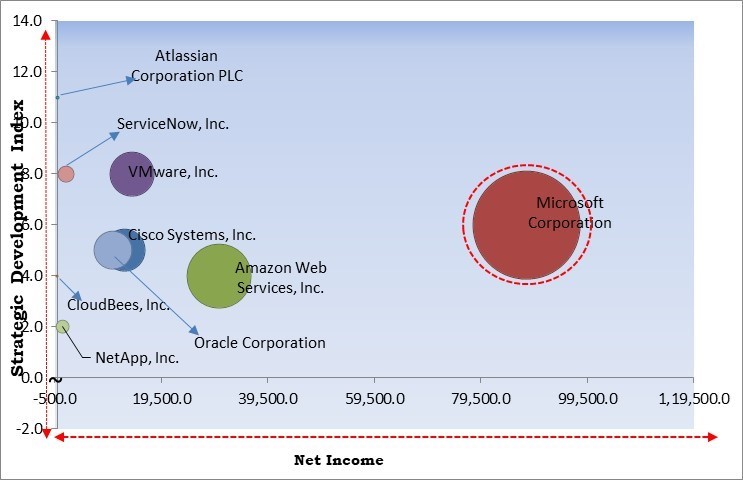
The increasing adoption of cloud platforms and hybrid IT environments has transformed how businesses manage their IT infrastructure. As organizations migrate to cloud services like AWS and Microsoft Azure, they face the challenge of managing complex, interconnected systems that span cloud and on-premise environments. Hence, as cloud adoption grows, robust management solutions will remain critical in helping organizations scale efficiently and maintain control over their hybrid and multi-cloud environments.
Digital transformation is reshaping industries globally as businesses across retail, manufacturing, healthcare, and financial services increasingly adopt digital technologies to enhance operations, improve customer experiences, and stay competitive. Retail businesses are adopting e-commerce platforms, digital payment systems, and customer analytics tools to enhance user experiences and streamline supply chains. Thus, the digital transformation across industries has greatly expanded the need for management systems.
Thus, the digital transformation across industries has greatly expanded the need for management systems. Beyond the initial purchase, additional expenses for customization, integration, and regular upgrades further increase the financial burden. Hence, though larger enterprises may be better equipped to handle these costs, the lack of affordable solutions for smaller businesses hampers widespread adoption, slowing the overall growth of the market.
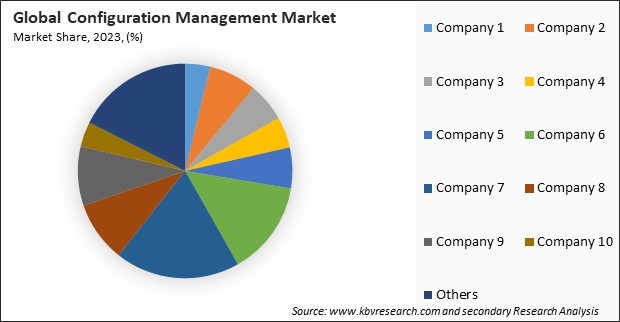
The leading players in the market are competing with diverse innovative offerings to remain competitive in the market. The above illustration shows the percentage of revenue shared by some of the leading companies in the market. The leading players of the market are adopting various strategies in order to cater demand coming from the different industries. The key developmental strategies in the market are Partnerships & Collaborations.
On the basis of enterprise type, the market is bifurcated into large enterprises and SMEs. The SMEs segment witnessed 38% revenue share in the market in 2023. SMEs are gradually realizing the importance of configuration management in ensuring system stability, security, and efficiency, even though they typically have less complex IT infrastructures than large enterprises.
Based on asset, the market is divided into server infrastructure, cloud resources, network devices, security devices, and edge infrastructure. The cloud resources segment procured 24% revenue share in the market in 2023. As more organizations adopted cloud-based infrastructures, the need for tools to manage configurations across diverse cloud environments became critical.
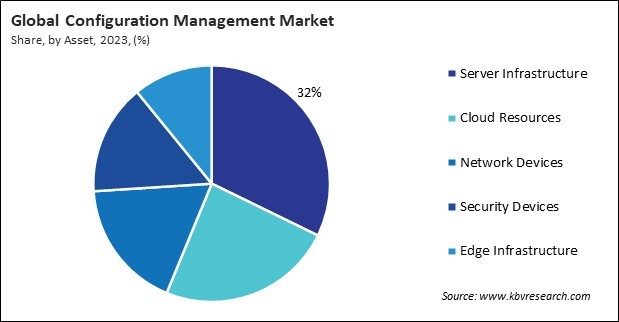
By industry, the market is classified into BFSI, retail, healthcare, manufacturing, IT & telecom, and others. The healthcare segment procured 27% revenue share in the market in 2023. The healthcare industry's rapid digital transformation, fueled by adopting electronic health records (EHRs), telemedicine, and data analytics, increased the need for configuration management tools.
Free Valuable Insights: Global Configuration Management Market size to reach USD 6.9 Billion by 2031
Region-wise, the configuration management market is analyzed across North America, Europe, Asia Pacific, and LAMEA. The North America segment recorded 36% revenue share in the configuration management market in 2023. The robust presence of large enterprises that heavily rely on configuration management tools to maintain operational efficiency and security, the widespread adoption of cloud computing, and the region's advanced IT infrastructure are all contributing factors to this dominance.
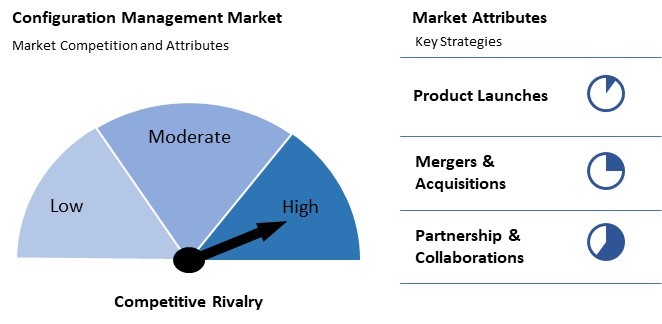
The competition in the Configuration Management Market is intense, driven by increasing demand for efficient IT infrastructure management. Key players offer advanced tools for real-time monitoring, version control, and compliance. Established vendors face growing competition from emerging companies focusing on automation, cloud integration, and AI-powered solutions.
| Report Attribute | Details |
|---|---|
| Market size value in 2023 | USD 2.3 Billion |
| Market size forecast in 2031 | USD 6.9 Billion |
| Base Year | 2023 |
| Historical Period | 2020 to 2022 |
| Forecast Period | 2024 to 2031 |
| Revenue Growth Rate | CAGR of 15.0% from 2024 to 2031 |
| Number of Pages | 258 |
| Number of Tables | 393 |
| Report coverage | Market Trends, Revenue Estimation and Forecast, Segmentation Analysis, Regional and Country Breakdown, Competitive Landscape, Market Share Analysis, Porter’s 5 Forces Analysis, Company Profiling, Companies Strategic Developments, SWOT Analysis, Winning Imperatives |
| Segments covered | Enterprise Type, Asset, Industry, Region |
| Country scope |
|
| Companies Included | VMware, Inc. (Broadcom Inc.), Atlassian Corporation PLC, Cisco Systems, Inc., Microsoft Corporation, Oracle Corporation, CloudBees, Inc., Puppet, Inc. (Perforce Software, Inc.), ServiceNow, Inc., Amazon Web Services, Inc. (Amazon.com, Inc.) and NetApp, Inc. |
By Enterprise Type
By Asset
By Industry
By Geography
This Market size is expected to reach $6.9 billion by 2031.
Growing cloud adoption and hybrid IT environments are driving the Market in coming years, however, Requirement for high implementation costs restraints the growth of the Market.
VMware, Inc. (Broadcom Inc.), Atlassian Corporation PLC, Cisco Systems, Inc., Microsoft Corporation, Oracle Corporation, CloudBees, Inc., Puppet, Inc. (Perforce Software, Inc.), ServiceNow, Inc., Amazon Web Services, Inc. (Amazon.com, Inc.) and NetApp, Inc.
The expected CAGR of this Market is 15.0% from 2024 to 2031.
The Server Infrastructure segment led the Market by Asset in 2023; thereby, achieving a market value of $2.1 billion by 2031.
The North America region dominated the Market by Region in 2023, and would continue to be a dominant market till 2031; thereby, achieving a market value of $2.4 billion by 2031.
Our team of dedicated experts can provide you with attractive expansion opportunities for your business.

 Drivers
Drivers
 Restraints
Restraints
 Opportunities
Opportunities
 Challenges
Challenges
